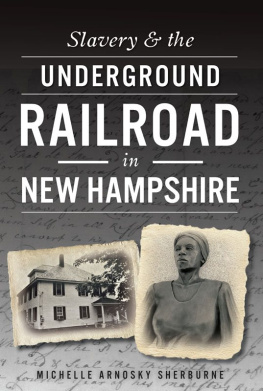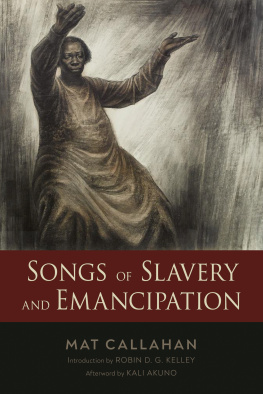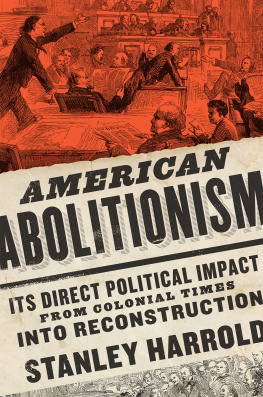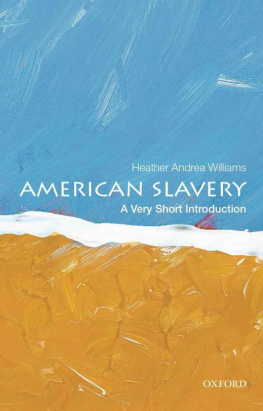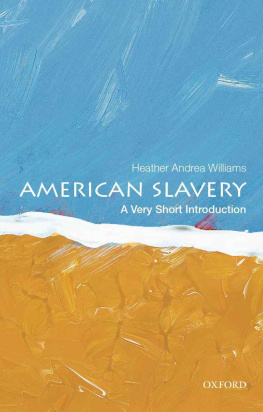American Abolitionists
First published 2001 by Pearson Education Limited
Published 2014 by Routledge
2 Park Square, Milton Park, Abingdon, Oxon OX14 4RN
711 Third Avenue, New York, NY 10017, USA
Routledge is an imprint of the Taylor & Francis Group, an informa business
Copyright 2001, Taylor & Francis.
The right of Stanley Harrold to be identified as author of this work has been asserted by him in accordance with the Copyright, Designs and Patents Act 1988.
All rights reserved. No part of this book may be reprinted or reproduced or utilised in any form or by any electronic, mechanical, or other means, now known or hereafter invented, including photocopying and recording, or in any information storage or retrieval system, without permission in writing from the publishers.
Notices
Knowledge and best practice in this field are constantly changing. As new research and experience broaden our understanding, changes in research methods, professional practices, or medical treatment may become necessary.
Practitioners and researchers must always rely on their own experience and knowledge in evaluating and using any information, methods, compounds, or experiments described herein. In using such information or methods they should be mindful of their own safety and the safety of others, including parties for whom they have a professional responsibility.
To the fullest extent of the law, neither the Publisher nor the authors, contributors, or editors, assume any liability for any injury and/or damage to persons or property as a matter of products liability, negligence or otherwise, or from any use or operation of any methods, products, instructions, or ideas contained in the material herein.
ISBN 13: 978-0-582-35738-9 (pbk)
British Library Cataloguing-in-Publication Data
A catalogue record for this book is
available from the British Library
Library of Congress Cataloging-in-Publication Data
Harrold, Stanley
American abolitionists / Stanley Harrold.
p. cm. -- (Seminar studies in history)
Includes bibliographical references (p.) and index.
ISBN 0-582-35738-1 (ppr)
1. Abolitionists--United States--History. 2. Antislavery movements--United
States--History. I. Title. II. Series.
E449 .H298 2000
326.80973--dc2100-061472
Set by 7 in 10/12 Sabon Roman
For Lee Harrison Harrold
Such is the pace of historical enquiry in the modem world that there is which inevitably become out of date. Seminar Studies in History is designed to bridge this gap. The series was founded by Patrick Richardson in 1966 and his aim was to cover major themes in British, European and world history. Between 1980 and 19% Roger Lockyer continued his work, before handing the editorship over to Clive Emsley and Gordon Martel. Clive Emsley is Professor of History at the Open University, while Gordon Martel is Professor of International History at the University of Northern British Columbia, Canada, and Senior Research Fellow at De Montfort University,
All the books are written by experts in their field who are not only familiar with the latest research but have often contributed to it. They are frequently revised, in order to take account of new information and interpretations. They provide a selection of documents to illustrate major themes and provoke discussion, and also a guide to further issues without over-simplifying them, and to stimulate readers into deepening their knowledge and understanding of major themes and
Readers should note that numbers in square brackets [] refer them to the corresponding entry in the Bibliography at the end of the book (specific page numbers are given in italics). A number in square brackets preceded by Doc. [Doc. 5] refers readers to the corresponding item in the Documents section which follows the main text.
| AAS | American Abolition Society |
| AASS | American Anti-Slavery Society |
| ACS | American Colonization Society |
| AFASS | American and Foreign Anti-Slavery Society |
| AMA | American Missionary Association |
| MASS | Massachusetts Anti-Slavery Society |
| NEASS | New England Anti-Slavery Society |
| PFASS | Philadelphia Female Anti-Slavery Society |
We are grateful to the following for permission to reproduce copyright material:
Plate 1, portrait of Elizabeth Mumbet Freeman by Susan Anne Livingston Ridley Sedgwick, reproduced courtesy of the Massachusetts Historical Society; Plate 2, mob attacking the warehouse in Alton, Illinois CORBIS, Plate 4, Frederick Douglass Bettmann/CORBIS, Plate 7, Sojourner Truth Bettmann/CORBIS, Plate 8 Gerrit Smith CORBIS, all reproduced courtesy of Corbis; Plate 5, portrait of Lydia Maria Child, reproduced courtesy of The Schlesinger Library, Radcliffe Institute, Havard University.
While every effort has been made to trace the owners of copyright material, in a few cases this has proved impossible and we take this opportunity to offer our apologies to any copyright holders whose rights we have unwittingly infringed.
Although the author is responsible for all errors in fact and interpretation, this book has benefited from the work of many historians as well as the dedicated staff at Pearson Education. Special thanks are due to a half-dozen scholars who generously donated their expert advice. They are: Frederick I. Blue, Edmund L. Drago, Douglas R. Egerton, Sylvia Hoffert, John R. McKivigan, and Shirley J. Yee. Just as important was the wise counsel provided by the Seminar Studies in History Series Editor Gordon Martel and Pearson Education Senior Acquisitions Editor Emma Mitchell. Thanks are due as well to Heather McCallum, Sarah Bury and Verina Pettigrew for their efforts in preparing the book for publication.

Map 1 The United States in September 1850
American abolitionists were people - black and white, female and male -who during the eighteenth and nineteenth centuries sought to end slavery and secure racial justice. They were part of a broader struggle within the Atlantic World against the enslavement of Africans and people of African descent. As a result of this straggle, a system of unfree labor that in 1750 existed throughout the British, Dutch, French, Portuguese, and Spanish empires in the New World had disappeared by 1888.
In the United States, which declared its independence from Great Britain in 1776, the antislavery effort faced especially determined opposition. Years of conflict between antislavery forces, located mainly in the North, and pro-slavery forces, centered in the South, preceded the emancipation of all American slaves. The unwillingness of African Americans to remain in bondage, profound economic and ideological change associated with the industrial revolution, and major evangelical revivals shaped a powerful antislavery impulse. Bet strong economic, cultural, and racial interests made American slavery a resilient phenomenon. Even after the formal abolition of slavery in 1865, these interests prevented African Americans from enjoying the same legal rights and economic opportunities as white Americans [].


